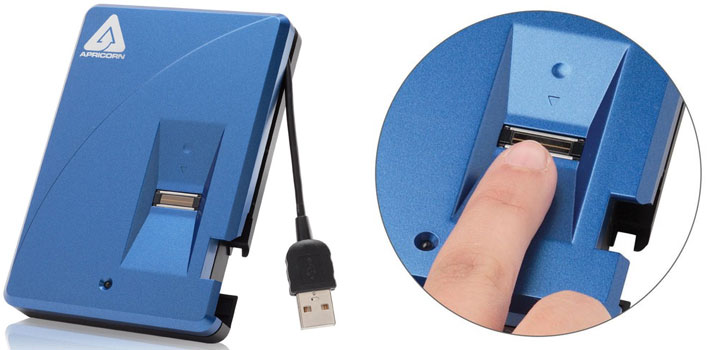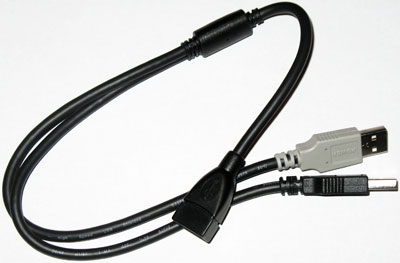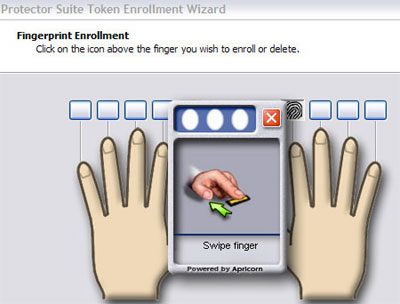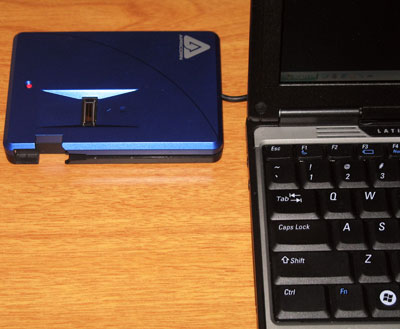While the Aegis has a lot of strong points, issues with peripheral features like the length of the connection cable, the included software, and the overall price mean this 2.5-inch drive doesn't have enough to set it apart from the rest of the pack.

January 2008 Eric Hanson
Contents
Biometric Security
Apricorn put all of the features you’d want to see in a security-conscious hard drive in the Aegis Bio: Hi-Speed USB 2.0 connection for faster file transfers, real-time 128-bit AES encryption that’ll protect your data even if a thief disassembles the drive from its housing, UPEK TouchStrip Fingerprint Sensor with Oxford Controller Chip for biometric access without accessing the host computer’s operating system, a 16-point omni-directional shock mounting system to protect the drive against drop damage, an alternating red and green LED system that tells you whether or not the drive is locked, and a light 5.5 ounce total weight.
Inside the housing is a 2.5″ Fujitsu hard drive (drive supplier might vary), with an operating speed of 5400 rpm and an 8MB cache. The drive includes a built-in USB cable, but the five inch length is not particularly practical when working with desktops. The Aegis Bio also comes with a software disc for adding and removing fingerprints to the drive’s password bank, along with a link to download SyncToy, a free power toy for Windows that drive synchronization and backups.
Installation
After you’ve completed the software installation, you’ll need to run the Protector Suite Token program to enable the drive’s biometric security. Protector Suite Token is a Windows-only program, which means that you’ll need to setup the drive on a Windows machine before you can use it with a Mac, a feature that Apricorn does not make clear from the box or in the instructions. To get started, you’ll need to plug in the drive to the nearest USB port; if the port doesn’t provide enough power, you’ll need to use the included Y cable and a second USB port to complete the connection.

A USB Y Cable for those computers with lower powered USB connections.
Fingerprint enrollment is a simple process: after watching the animated tutorial that shows you how to swipe your finger correctly, you choose the fingerprint you want to save to the drive from a diagram of a left and a right hand, and then follow the instructions in a new dialog box. Apricorn requires you to swipe the same finger three times to ensure an accurate read, which seems like a good safety feature, and seems to correlate with the sensor’s lack of sensitivity – I had to use my right hand, because chronic dry skin on my left hand seems to have changed my fingerprints enough to make them difficult to read. The software recommends you enroll two fingers – in case you can’t use your finger of choice for any reason – but beware: the Aegis Bio only allows you to register ten fingers at a time total, not per person. In other words, if you’re planning on sharing this drive with more than ten people (or five people if you do the double registration), the Aegis Bio is not for you.

Fingerprint enrollment is a matter of three swipes and a dialog box.
One additional note about multiple fingerprint enrollments: the software does not split up the drive into new partitions when you add new fingerprints. I’m guessing that this lack of separation is because it could cause data loss if the software added a new partition to a full drive; in addition, because the software doesn’t distinguish between users, only between fingerprints, it could end up setting up multiple partitions for the same user, causing confusion. I’m not sure this problem is so much of a problem anyway; the Aegis Bio’s size and limited number of fingerprint enrollments makes it much more appropriate for either a single user or a small cooperative group, not as a large portable data server.
In case the sensor on the drive fails – or you burn your fingerprints off with acid, or something like that – the setup program will ask you for a backup password, which it stores as an XML file in the location of your choice; the default is the My Documents folder of the person who did the setup. After you enter your backup password, the software opens up a formatting utility so you can quick format the drive and start backing up your data. After you finish the process, Protector Suite Token installs itself in your system tray, giving you quick access to program settings, the option to lock the drive from further modification, and the ability to add new fingerprints to the biometric sensor.

When your computer has USB ports in the back, the short cable becomes a real disadvantage.
Password Manager for IE and Firefox
Remembering passwords is a pain; writing them down or even saving them to cookies is dangerous and – if you’re required to observe certain levels of security – possibly even illegal. Apricorn takes this problem into account with an interesting solution: save the passwords to a bank that’s accessible only by a fingerprint swipe to the Aegis Bio’s sensor and list them in one section of the Protector Suite Token.
The registration process, which works with Internet Explorer (versions 5.5 and up) and Firefox (versions 1.0 and up), requires you to fill in your username and password in the webpage’s dialog box, then press a shortcut key combination of your choice – the default is Ctrl + Alt + Home. Doing so opens up a finger swipe dialog in Protector Suite Token; pass that security challenge and the program will save the URL of the site and your login information to the password bank. To access the saved page, select it from the list of registered sites in Protector Suite Token, and then swipe your finger; the program will load the site in your default browser. By default, the program submits the form after it fills in the information so there’s no way someone lurking nearby can see the username and password length. There’s even a help tip (which you can disable) that pops up when your browser loads a page you can register, which I thought was a great reminder when you’re first learning to use the feature.
Windows XP Log In Control
The Aegis Bio can also help add an extra layer of security when logging in to a Windows XP computer. As with the password bank, some enrollment is required – you’ll need to swipe your finger, then enter your XP user name and password the first time you use it – but after this first enrollment you can use the biometric finger swipe to log in instead of entering your password. However, unlike the password bank, the log in control doesn’t really add that much extra security; you can still log in without the drive attached, and you can disconnect the drive before you log in to disable the biometric access. To be really effective, the log in security feature should disable Windows log in without the finger swipe.
Transfer Speeds
Security may be the paramount concern for Aegis Bio users, but transfer speed will always run a close second – who wants Apricorn’s brand of security if it takes ten times as long to transfer a file? To find out just how fast the Aegis Bio can transfer a file over its Hi-Speed USB 2.0 connection onto the hard disk, I ran two different drive testing utilities: Simpli Software’s HD Tach (version 3.0.1.0) and SiSoftware’s Sandra Lite XII.SP1 (version 2008.1.13.12). To see how well the Aegis Bio performs in different operating environments, I ran each set of tests on two different computers: a desktop with an AMD processor and a NVIDIA nForce 590 SLI chipset, and a laptop with an Intel process and a Mobile Intel 945GM Express chipset.
Quick Bench (Mobile Intel 945GM plugged in):

HD Tach quick bench results from the Mobile Intel 945 GM chipset, running on AC power.
- Random access: 18.4 ms
- CPU utilization: 0 percent
- Average read: 27.4 MB/s
- Burst speed: 22.3 MB/s
If you’re looking for a justification to get a dual core processor for your next laptop, the benchmarks from HD Tach give you ample reason: the CPU utilization drops from 21 percent on the laptop’s single core processor to 0 percent on the desktop’s dual core in the short bench files, with the difference presumably resting (at least in part) on dual core optimizations of the drive’s encryption algorithms. However, every other stat from this benchmark suggests that you’d be better off using this drive with a newer chipset, which seems to have the optimizations to get files on and off the drive faster, particularly when working with larger files.
Speed Tests with Sandra Lite XII.SP1
Sandra has a removable storage benchmark that combines five individual file tests of sizes from 512 bytes to 64 megabytes for testing objects like flash drives and USB hard drives. Here are the results from both computers; plugged in indicates the laptop was running on AC power, battery that the laptop was running on battery power only:
nForce 590:
- Combined index: 2786 operations/min
- Endurance factor: 3.60
Mobile Intel 945GM (AC):
- Combined index: 3714 operations/min
- Endurance factor: 3.30
Mobile Intel 945GM (Battery):
- Combined index: 3737 operations/min
- Endurance factor: 3.40
The results from Sandra jive with those of HD Tach: the laptop’s newer chipset has better connectivity resulting in faster transfers. That said, 3884 operations per minute is not particularly speedy – a 3.5 inch external drive without encryption and faster drive specs will do about 21,000 operations per minute – and if you make frequent use your laptop’s battery, your transfer speeds may be even slower. The benchmark’s endurance factor is a measure of life expectancy for external drives, computed as a function of the speed of transfer of average-sized files by the speed of transfer of the largest files. Hard drives are not particularly durable devices, explaining why the drive has such low scores; also note that when the drive scores a higher performance index, it garners a lower endurance factor.
Recap
If encryption and biometric security are necessary parts of your data storage solutions, the Aegis Bio makes a good case for itself to be your drive of choice; its shock-mounted case (and three year warranty) suggests durability, while the fingerprint scanner works well enough that biometric access isn’t a pain to use. However, there are a couple of issues to address: first, the drive’s short connection cable is an irritant, especially when dealing with desktops; Apricorn should increase the cable length, and expand the size of the case to add a retractable cable management system. Second, the drive’s cost is higher than competing options, but doesn’t include options (like a robust backup software package) that would justify the higher cost.
Nexcopy manufactures a variety of PC-based and standalone USB duplicator solutions.
PC based systems support advanced USB functions such as write protection, CD-ROM partition and multi-partition creation, while standalone systems are ultra-fast, high speed USB copiers duplicating gigabytes of data quickly and accurately.

